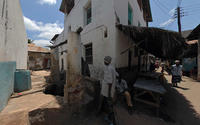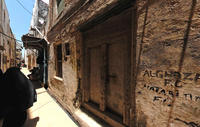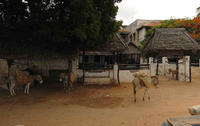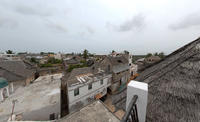You are in: Africa -> Kenya -> Lamu Old Town, and traditional search or Image Gallery will yield results of this site only
Lamu Old Town
| Site number: | 1055 |
|
| Type of site: | Cultural | |
| Date: | 14th century | |
| Date of Inscription: | 2001 | |
| Location: | Africa, Kenya, Coast Province, Lamu District | |
Up to 75 images are shown here. Click on each for more details or on Image Gallery for more images.
| Description: | The oldest and best-preserved Swahili settlement in East Africa, Lamu Old Town retains its traditional functions. The town, constructed in coral stone and mangrove timber, is distinguished by the minimalism of structural forms that are enhanced by inner courtyards, verandas, and intricately carved wooden doors. Since the 19th century Lamu has held various significant Muslim religious festivals, and has grown to be a major centre for the study of Islamic and Swahili cultures. - --WHMNet paraphrase from the description at WHC Site, where additional information is available. For 360 degree imaging of this site, click here. | |
| Lamu town is the largest town on Lamu Island, which in turn is a part of the Lamu Archipelago in Kenya. Lamu town is also the headquarters of Lamu District and a UNESCO World Heritage Site. The town was founded in the 14th century and it contains many fine examples of Swahili architecture. The old city is inscribed on the World Heritage List as "the oldest and best-preserved Swahili settlement in East Africa". Once a center for the slave trade, the population of Lamu is ethnically diverse. Lamu was on the main Arabian trading routes, and as a result, the population is largely Muslim. Due to the narrowness of the streets, automobiles are not allowed - the city is easily explored by foot, bicycle, or, as many locals favour, donkey. Notable buildings in Lamu town include: Lamu Fort: Fumo Madi ibn Abi Bakr, Sultan of Pate, started to build the fort on the seafront, to protect members of his unpopular government. He died in 1809, before the first storey of the fort was completed. Riyadha Mosque: Habib Salih, a Sharif with family connections to the Hadramaut, Yemen, settled on Lamu in the 1880s, and became a highly respected religious teacher. Habib Salih had great success gathering students around him and in 1900 the Riyadha Mosque was built. He introduced Habshi Maulidi, where his students sang verse passages accompanied by tambourines. After his death in 1935 his sons continued the Madrassa, which became one of the most prestigious centers for Islamic Studies in East Africa. The Mosque is the centre for the Maulidi Festival, which are held every year during the last week of the month of the Prophet´s birth. During this festival pilgrims from Sudan, Congo, Uganda, Zanzibar and Tanzania join the locals to sing the praise of Mohammad. --Wikipedia. Text is available under the Creative Commons Attribution-ShareAlike License. For 360 degree imaging of this site, click here. | ||
| Source: | http://whc.unesco.org/en/list/1055 | |
| Reference: | 1. UNESCO World Heritage Center, Site Page. | |








































































